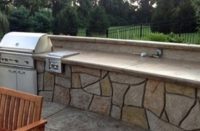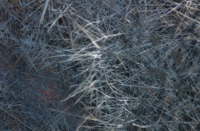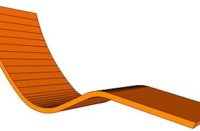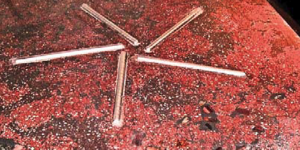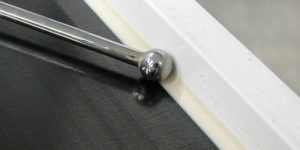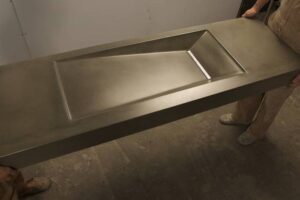When I entered the concrete countertop industry after 25 years in the architectural precast industry, I had a hard time understanding some of the practices in use. There seemed to be a lot of misinformation surrounding the how and why of mix designs when it came to concrete countertops. Some of the practices, such as leaving the countertop in the mold for days on end, made no sense to me. Failures were common.
The industry was (and is) suffering from a lack of overall quality that starts with high-performance mix design.
I’m going to explain the process and ingredients that go into making quality high-performance concrete. Nothing I state should be considered an absolute. Everything from ingredients to casting and curing practices works in concert with everything else to produce a quality end product. There are many different roads leading to an acceptable mix. I’m going to present a few simple principles that will start you down the road. Specifically, I will discuss the components, and then the role of each component, in a typical wet-cast mix.
I learned to design mixes prior to the advent of Microsoft Excel, so a pencil, paper and calculator is all you will need to follow along.

Wet-cast mix ingredients and their respective functions
Cementitious binder: The glue that holds things together. The majority of fabricators use portland type I, so this is what we’ll use when designing our basic mixes. Portland cement is ubiquitous. Don’t be confused by portland cement that is labeled “type I/II,” as this simply means that it meets the ASTM requirements of type I and type II at the same time. Portland can be either white or gray. Portland cement is hydraulic cement, which means that it reacts with water to hydrate. I would recommend finding a good source, preferably local, and sticking with it. Color and chemistry vary considerably from mill to mill.
You could also use CSA cement (calcium sulfoaluminate cement), or exotic cements such as magnesium phosphate cement or geopolymer cements. I would start with portland – get good with it, and then experiment.
Pozzolan: A pozzolan is a material that exhibits cementitious properties when combined with calcium hydroxide, a byproduct of portland cement hydration. You do not need to use pozzolans to make concrete countertops, but you can make denser, stronger concrete when you use them. The use of pozzolans also mitigates ASR (alkali-silica reactivity), which can occur in mixes containing glass or reactive aggregates. Concrete made with a pozzolan may require an accelerator and heat to equal the early strength of concrete made without a pozzolan.
We are going to use VCAS (vitrified calcium aluminosilicate) as our pozzolan. I’ve tested and used just about every pozzolan over the years and have settled on VCAS as suitably meeting my needs. Some other pozzolans used by countertop makers include silica fume, granulated blast furnace slag, metakaolin, finely ground glass, and fly ash.
Large aggregate: I use a well-graded 3/8-inch minus pea gravel as my large aggregate in wet-cast mixes. You should be able to source this locally. Just about any sound inorganic aggregate can be used to get the look you want. You can use aggregate larger than 3/8-inch but your mix would be less homogenous in thin-section countertops.
Fine aggregate: I use sand made for concrete (conforming to ASTM C-33) rather than gap-graded sand in my wet-cast. Concrete sand conforming to ASTM C-33 is readily available at ready-mix producers or sand quarries. It contains a range of sizes. Gap-graded means that the particles will fit through a certain size of screen (such as No. 30) but not the next size of screen (such as No. 40).
Fibers: I use PVA (polyvinyl alcohol) fiber in wet-cast mixes. Why PVA? I’ve found PVA fiber works to control drying shrinkage and improve impact resistance.
Basic chemicals: We will be chemically altering our concrete to boost the performance and to impart properties (such as flowability) that make our countertops easier to cast and have fewer bug-holes.
Superplasticizers, aka high-range water reducers: Super P makes the concrete more fluid without your adding more water. We are going to use Optimum 380, available from FishStone.
Mid-range water reducers: We might want to use a mid-range water reducer if we were pouring in place and trowel-finishing our countertops. Mid-range water reducers tend to finish better than high-range water reducers, and what’s more, we don’t need as fluid a mix in poured-in-place applications. You would use either a mid-range or a high-range water reducer, but not both.
The goal is to get the concrete fluid enough to place without adding water, which weakens the mix.
Additional chemicals: As you get into more advanced mix designs you may want to use these chemicals to further boost your concrete’s performance.
Viscosity-modifying admixtures: VMAs are used in conjunction with high dosages of superplasticizer. The super makes the concrete more fluid, which can cause the mix to experience segregation. VMAs help prevent this by modifying the viscosity. You have to be careful when dosing, because VMAs can also make it harder for trapped air to migrate through the mix, which can lead to more bug-holes. Just enough to prevent segregation is enough.
High dosages of super plus a VMA are how you make self-consolidating concrete. VMAs were developed to cast concrete underwater with minimal segregation.
Shrinkage-reducing admixtures: SRAs help prevent drying shrinkage of concrete. They are also powerful air detrainers. The end result is one component in slab curl and bug-hole prevention. SRA are the most dangerous chemicals that we use, not to us but to the concrete. You can halve the strength of your mix if you overdose with them.
Nonchloride accelerators: I use a combination of accelerators and heat to enable me to strip and process our countertops 14 hours after casting using type I portland.
Qwix: Qwix is a cementitious calcium sulfoaluminate (CSA) additive used to increase the strength development and ultimate strength of concrete mixes. It also helps reduce porosity and shrinkage. On top of that, Qwix is a very powerful accelerator.
What happens when you use all of the above chemicals in different combinations? I have no idea. I would start building your high-performance mix with the addition of a super P. Determine a dosage that works for you, get a base line, then add other chemicals one at a time and decide if they make your mix better. For instance, an SRA may help keep your slabs from curling and reduce bug-holes, while Qwix may have a similar effect plus act as an accelerator. Using a SRA plus Qwix plus an accelerator? My guess is you’d be lucky to get it out of your mixer on a hot day. Walk before you run.
Recipe for a wet-cast mix
We are going to design our wet-cast mix based on a yield of 1 cubic yard. One cubic yard equals 27 cubic feet. You will use simple volume calculations to arrive at batch weights for your yield.
You will move between weight and volume for each ingredient by dividing the batch weight of each ingredient by the weight per cubic foot of each ingredient to arrive at the batch volume for each ingredient.
Cement: I would stay under 800 pounds per cubic yard for wet-cast countertops. Somewhere around 750 to 800 pounds per cubic yard of cement, the strength curve begins to flat-line, eventually going downward somewhere around 1,200 pounds. Cement shrinks, a big problem the more you use. It’s a case of diminishing returns and performance.
750 pounds cement ÷ 196.65 pounds per cubic foot = 3.81 cubic feet
Batch Volume: 3.81 cubic feet
Pozzolan: I would stay at around 10 percent of the cement weight. You could go as high as 20 percent, but this would severely affect the setting times (longer) without giving you much additional benefit (depending on the pozzolan). As I stated already, you don’t need a pozzolan, but you can make denser, stronger concrete when you use one.
75 pounds VCAS ÷ 163.49 pounds per cubic foot = 0.46 cubic feet
Batch Volume: 0.46 cubic feet
Water: I would want my water-to-cement ratio (pounds of water divided by pounds of cement) to be between 0.30 and 0.34. I know this will give me a mix design with an ultimate strength of 8,000 to 10,000 psi. We will use a superplasticizer to gain fluidity. Use the cement weight plus pozzolan to calculate your water-to-cement ratio.
Total Cementitious Material = 750 + 75 = 825 pounds
825 x 0.32 W/C = 264 pounds of water
264 pounds ÷ 62.4 pounds per cubic foot of water = 4.2 cubic feet
Batch Volume: 4.2 cubic feet
By the way, water weighs 8.33 pounds per gallon, so:
264 pounds of water ÷ 8.33 pounds per gallon = 31.7 gallons
Air: Your mix will contain some air, which has to be factored into your total volume. I would estimate 3 percent based on experience. 3 percent of 27 cubic feet (1 cubic yard) = 0.81 cubic feet
Batch Volume: 0.81 cubic feet
Sand and Stone: This becomes a balancing act between sand, which provides a fluid, easily consolidated mix with few bug-holes, and stone for strength, appearance and less shrinkage. The higher the sand content, the lower the strength and the higher the shrinkage as a general rule. A 50/50 mix seems to be a good compromise. Cubic feet so far in our 27-cubic-foot (1 cubic yard) batch:
Cement: 3.81 cubic feet
Pozzolan: 0.46 cubic feet
Water: 4.2 cubic feet
Air: 0.81 cubic feet
Total: 9.28 cubic feet
Stone and sand needed = 27 cubic feet – 9.28 cubic feet = 17.72 cubic feet, or 8.86 cubic feet of stone and 8.86 cubic feet of sand
We need to multiply the required cubic feet by the pounds-per-cubic-feet weight of sand and of stone.
Stone: 8.86 x 169.7 pounds per cubic foot = 1,504 pounds
Sand: 8.86 x 163.4 pounds per cubic foot = 1,448 pounds
Chemical dosages: You will have to play with dosages of chemicals to find out what works for you. Your mix ingredients will react differently to chemicals than mine will. I would start with the manufacturer’s recommended dosages and work from there. Remember you are dosing the superplasticizer high enough to maintain your water-to-cement ratio. Conclusion: Our weights for 1 cubic yard of our sample wet-cast mix design:
Portland cement = 750 pounds
VCAS = 75 pounds
Sand = 1,448 pounds
Stone = 1,505 pounds
Water = 264 pounds
PVA fiber = 4 pounds
Chemicals as needed
You may need to compensate for water in your aggregate. Sand can hold up to 10 percent moisture. Stone can only hold about 2 percent moisture before water freely runs out of it. If your sand is damp and you guessed at 5 percent moisture you would be within a couple of percentage points, which is close enough.
This mix calls for 1,448 pounds of sand. Sand is 5 percent moisture – in this case, 72.4 pounds of moisture. Add 5 percent more sand by weight (72.4 pounds worth), and subtract the water you are weighing in the sand from your water total.
Adjusted sand = 1,448 + 72.4 = 1,520.4 pounds
Adjusted water = 264 – 72.4 = 191.6 pounds
You now have a wet-cast mix utilizing local materials that should cost you about $1.50 per square foot for 1.5-inch-thick countertops.
With a little experimentation, you can create all-sand wet-cast mixes, mixes with just about any aggregate to get any look you want, hand-press mixes, all-glass mixes, self-consolidating mixes, and so on.
Mark Celebuski was the general manager of Pinnacle Cast Concrete, a successful concrete countertop company. He is also an international distributor of concrete countertop manufacturing equipment, and he holds monthly training sessions for professionals at his plant. He has worked in the architectural/structural precast concrete field for the last 30 years, completing more than 15 million square feet of projects.
RESOURCES
www.trinic.us
www.ball-consulting-ltd.com
www.basf-admixtures.com/EN/Pages/default.aspx
www.concretecountertopsupply.com/store/ccp0-display/Home.html
www.euclidchemical.com
www.fritzpak.com
www.grace.com
www.ball-consulting-ltd.com
www.negamerica.com
www.nycon.com
